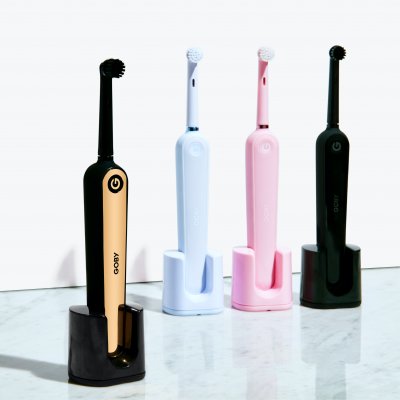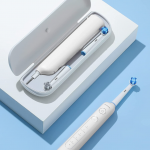There have been several technological advancements to the design and mechanism of a toothbrush. Some tackle the overall look and design of the toothbrush. While others work on ways to make the whole mechanism work better than the previous models.
Lots of innovation comes and goes but the one that reigns supreme right now is the electric toothbrush. It works by using an electric motor and movable brush head to give extra power to the brushing motion. It usually creates some sort of rotating, oscillating, and vibrating movements to help remove the plaque from your teeth.
Although experts have found that an electric toothbrush works more than 10 times better than a manual toothbrush. It still couldn't achieve the desired level of hygiene. And that is because an electric toothbrush doesn't address the source of the problem, which is why the plaque sticks to our teeth in the first place.
And that is where the Ionic toothbrush comes in. An ionic toothbrush is the only toothbrush that works on those fundamental levels. In this article, we'll talk about what an ionic toothbrush is, the history behind it, studies that support its use and effectiveness, and all the things that you need to know about an ionic toothbrush.
As the name implies, an ionic toothbrush is a toothbrush that utilizes the principle called ionic bonds in order to clean your teeth. A manual toothbrush or electric toothbrush could only focus on scrubbing the surface of your teeth.
An ionic toothbrush, on the other hand, works by severing the bonds that attract the plaque to your teeth. By working on fundamental aspects like this, ionic toothbrushes manage to deliver much cleaner teeth and remove significantly more plaque than other types of toothbrushes.
Appearance-wise, an ionic toothbrush looks very similar to a manual toothbrush. The only difference being a slightly bigger handle than the manual one in order to accommodate the ionic mechanism. But it is still much slimmer than the average electric toothbrush.
The chemical principle of ionic bonds has been around for centuries, or since around the 18th century to be exact. And the development behind the whole principle was spread over the years throughout several people. Each scientist improved upon the previous ideas.
From Michael Faraday that experiments in electrolysis around the 1830s and also introduced the term “Ion” (Greek words that mean "wanderer"), to Svante August Arrhenius that concludes that ion is an atom that carries either a positive or negative charge. And all the way to G.N. Lewis and his study called "Electronic Theory of Chemical Combinations" in 1916.
Likewise, the idea of using the principle of ionic bonds to devices like toothbrushes was also already there for a long time. Iontophoresis, electrophoretic, and electro ionizing are some of the terms that are often used to describe the implementation of such principles in dentistry.
But the one that clearly defined and created the template for all future ionic toothbrushes or similar devices was a man named Harry Pratt from Chicago, Illinois. He invented a device that resembled the modern ionic toothbrush and patented it in March 1889, under the name "Electromedical Brushes".
Although the patent was applied for a toothbrush-like device, Harry Pratt also mentioned that the basic principle, mechanism, and construction of the device could be implemented in other kinds of tools such as toilet brushes and other kinds of cleaning devices as well.
Using this patent as the basic template, different companies have created more modern ionic brushes. Brands such as Dr. Tung's, Soladey, and IONPA are some of the leading ionic toothbrush names in the industry right now. And although the base of their toothbrush remains the same, they manage to create different features to attract more customers to their brands.
An ionic toothbrush works by changing the polarity of your teeth. Under normal circumstances, teeth are negatively charged while the plaque is positively charged. Under the ionic bonds, opposite polarities attract each other while identical polarities repel each other.
Due to the opposite polarity between the two, plaques are automatically attracted and stick to your teeth. That's why no matter how hard you brush your teeth, either manually or using some kind of motor for the brush, you won't be able to totally sever that ionic bond.
Most ionic toothbrushes are equipped with a lithium battery inside of the handle. The battery is connected to a titanium rod that runs along the length of the toothbrush. Around the middle of the handle, there's a thin metal plate that is wrapped around the handle of the toothbrush.
In order to use an ionic toothbrush, all you need to do is simply put your moist thumb on the metal plate. This will initiate a static electric charge that would make the brush heads negatively charged. After that, all you need to do is just lightly brush your teeth with the bristle.
The interaction between the negatively charged bristle and the negatively charged teeth would turn your teeth' polarity from negative to positive. While you brush your teeth with an ionic toothbrush, your teeth and the plaques are now both positively charged.
As mentioned earlier, opposite polarities attract each other and identical polarities repel each other. That means the plaques will now be automatically repelled by your teeth. The more area that you brush with the bristle, the more plaques that would be repelled.
And since the brush itself is still negatively charged, the positively charged plaques will be attracted to the bristle. So not only will the teeth repel the plaques, but the bristle would also catch all of those repelled plaques. That's why an ionic toothbrush could significantly remove the plaques from your teeth.
There have been multiple studies conducted by scientists across the globe to find out about the effectiveness of ionic toothbrushes. Here's are some of the well-known ones:
This 1996 double-blind study was conducted with the help of sixty-four adult participants. The purpose of the study is to find out the effect of ionic toothbrushes on the removal of dental plaque and the reduction of gingivitis. Over the course of six months, the participants are carefully observed and instructed on the proper way to brush their teeth and also reminded to change the brush head every four weeks.
The result that the researchers find is a staggering 51.8% overall improvement in gingival health. Not only that, but the study also finds a whopping 48.69% plaque-removal rate to the participants' teeth. This highly significant result means that an ionic toothbrush is a safe and effective oral cleansing device.
This 2006 double-blind study was conducted with the help of 20 dental students with the age group ranging from 18 to 20 years old. Half of them are the test group that used active ionic toothbrushes (with lithium batteries).
The other half is the control group that used inactive ionic toothbrushes (without the lithium battery). The duration of the study is 49 days in order to find the difference between the plaque index and gingival bleeding index.
The result that the researchers see between the two groups was significantly different. Those who use the active ionic toothbrush see an 82% reduction in their plaque scores, 97% reduction in their bleeding index, while the other group only see a 20% reduction in plaque scores and a 33% reduction in their bleeding index.
- Clinical comparison of an electric-powered ionic toothbrush and a manual toothbrush in plaque reduction: A randomized clinical trial by researchers from Tokyo Medical and Dental University in Japan
This 2020 study was conducted on 30 healthy volunteers between the age of 25 and 32 years old. The participant was divided into two groups. One was a test group that used the ionic toothbrush, while the other ones were the control group. During the course of the study, the participants are carefully observed and instructed to brush their teeth for two minutes for each session using the correct brushing method.
The result of this study is similar to all the previous ones. Compared to manual toothbrushes, electric-powered ionic toothbrushes were significantly efficient in removing plaque in the premolar and molar areas. The test group had an 85.45% plaque removal rate while the control group had a 58.9% plaque removal rate.
IONPA DM White Compact Ionic Toothbrush
This ionic toothbrush from IONPA is one of the premium options on this list. This ionic toothbrush also has more features than the other brands in this list. Other than the usual ionic toothbrush features, IONPA DM White Compact is also equipped with a brushing timer and two brushing modes.
IONPA DM Compact ionic toothbrush also comes with more tools within the package. Other than the toothbrush itself, you would also get two brush heads and a travel-ready cap. This also makes IONPA DM COMPACT one of the most travel-friendly ionic toothbrushes in the market.
The price for this IONPA DM Compact Ionic Toothbrush is certainly higher than the previous brands, but it is still relatively affordable. When I write this article, you can get one unit of IONPA DM Compact Ionic Toothbrush for $39.00 before shipping. With a 4.6 out of 5 stars rating and three colors that you could choose from, this toothbrush is quickly becoming a favorite among customers.
If you truly care about your dental health and want to get much cleaner teeth, then you should use an ionic toothbrush. This type of brush works by removing the plaques on the fundamental level by forcing your teeth to repel the plaque through its ionic bonds.





